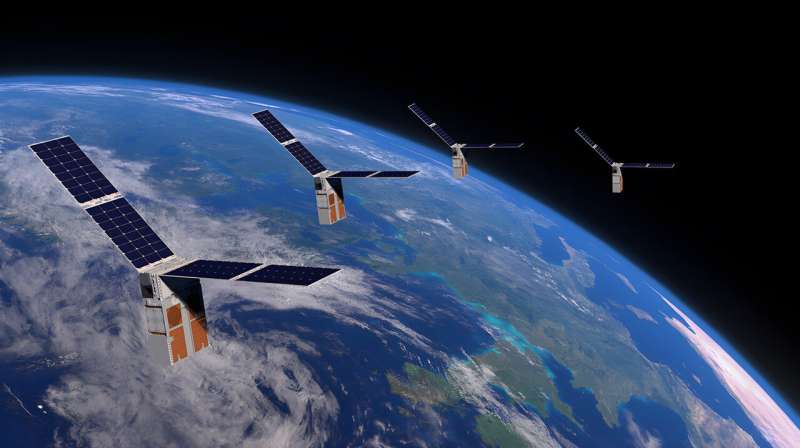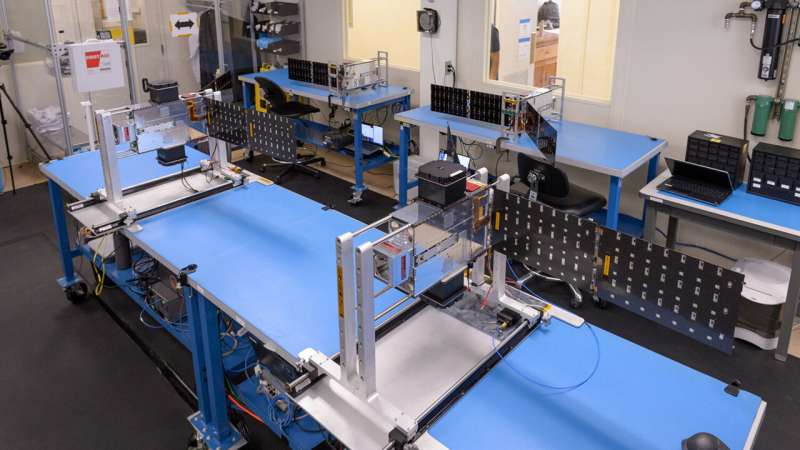
Someday, instead of large, expensive individual space satellites, teams of smaller satellites—known by scientists as a "swarm"—will work in collaboration, enabling greater accuracy, agility, and autonomy. Among the scientists working to make these teams a reality are researchers at Stanford University's Space Rendezvous Lab, who recently completed the first-ever in-orbit test of a prototype system able to navigate a swarm of satellites using only visual information shared through a wireless network.
"It's a milestone paper and the culmination of 11 years of effort by my lab, which was founded with this goal of surpassing the current state of the art and practice in distributed autonomy in space," said Simone D'Amico, associate professor of aeronautics and astronautics and senior author of the study, published on the arXiv preprint server. "Starling is the first demonstration ever made of an autonomous swarm of satellites."
The test is known as Starling Formation-Flying Optical Experiment, or StarFOX. In it, the team successfully navigated four small satellites working in tandem using only visual information gathered from onboard cameras to calculate their trajectories (or orbits). The researchers presented their findings from the initial StarFOX test at a gathering of swarm satellite experts at the Small Satellite Conference in Logan, Utah.

All the angles
D'Amico described the challenge as one that has driven his team for more than a decade. "Our team has been advocating for distributed space systems since the lab's inception. Now it has become mainstream. NASA, the Department of Defense, the U.S. Space Force—all have understood the value of multiple assets in coordination to accomplish objectives which would otherwise be impossible or very difficult to achieve by a single spacecraft," he said. "Advantages include improved accuracy, coverage, flexibility, robustness, and potentially new objectives not yet imagined."
Robust navigation of the swarm presents a considerable technological challenge. Current systems rely on the Global Navigation Satellite System (GNSS), requiring frequent contact with terrestrial systems. Beyond Earth's orbit, there is the Deep Space Network, but it is relatively slow and not easily scalable to future endeavors. What's more, neither system can help satellites avoid what D'Amico calls "non-cooperative objects" like space debris that might knock a satellite out of commission.
The swarm needs a self-contained navigation system that allows a high degree of autonomy and robustness, D'Amico said. Such systems are likewise made more attractive by minimal technical requirements and financial costs of today's miniaturized cameras and other hardware. The cameras used in the StarFOX test are proven, relatively inexpensive 2D cameras called star-trackers found on any satellite today.
"At its core, angles-only navigation requires no additional hardware even when used on small and inexpensive spacecraft," D'Amico said. "And exchanging visual information between swarm members provides a new distributed optical navigation capability."
Written in the stars
StarFOX combines visual measurements from single cameras mounted on each satellite in a swarm. Similar to a mariner of old navigating the high seas with a sextant, the field of known stars in the background is used as reference to extract bearing angles to the swarming satellites. These angles are then processed onboard through accurate physics-based force models to estimate the position and velocity of the satellites with respect to the orbited planet; in this case, Earth---but the moon, Mars, or other planetary objects would work as well.
StarFOX employs the Space Rendezvous Lab's angles-only Absolute and Relative Trajectory Measurement System—ARTMS, for short—which integrates three new space robotics algorithms. An Image Processing algorithm detects and tracks multiple targets in images and computes target-bearing angles—the angles at which objects, including space debris, are moving toward or away from each other. The Batch Orbit Determination algorithm then estimates each satellite's coarse orbit from these angles. Last but not least, the Sequential Orbit Determination algorithm refines swarm trajectories with the processing of new images through time to potentially feed autonomous guidance, control, and collision avoidance algorithms onboard.
More information: Justin Kruger et al, Starling Formation-Flying Optical Experiment: Initial Operations and Flight Results, arXiv (2024). DOI: 10.48550/arxiv.2406.06748
Journal information: arXiv
Citation: Engineers conduct first in-orbit test of 'swarm' satellite autonomous navigation (2024, August 8) retrieved 8 August 2024 from https://techxplore.com/news/2024-08-orbit-swarm-satellite-autonomous.html
This document is subject to copyright. Apart from any fair dealing for the purpose of private study or research, no part may be reproduced without the written permission. The content is provided for information purposes only.
